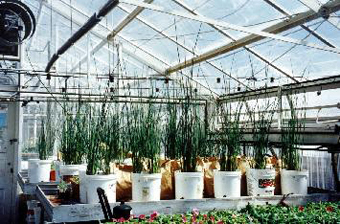Several research projects have focused on nutrient cycling and transformations within constructed wetlands designed to treat a variety of wastes.
These investigations include field and laboratory studies of wetlands constructed to remove nitrogen, phosphorus, and organic matter from domestic, food processing, and agricultural waste. In the full-scale subsurface flow wetland shown below, the wetlands are effectively removing BOD, nitrogen and phosphorus from domestic waste. Yet, the processes by which this removal occurs are imperfectly understood, and research on the mechanisms for treatment within wetlands will lead to better design criteria for these systems. Our research looks at the role of vegetation and alterations to the flow of waste to determine how nitrification/denitrification processes are affected.

Treatment wetlands are also designed and constructed to treat waste with different characteristics than typical domestic waste. For example, vegetable and fruit processing waste is typically low in nitrogen and phosphorus, and can vary dramatically in organic matter composition, depending on the commodity processed. We've conducted greenhouse experiments with cannery waste to determine the effectiveness of subsurface flow wetlands in removing BOD under low nutrient conditions.

Greenhouse experiments with wetland "mesocosms" exposed to cannery waste.

Cannery waste is highly variable. The above photo shows waste from the canning of beets.

Subsurface flow wetlands constructed to treat cannery waste at Rockview prison.

Completed wetland after vegetation establishment.

